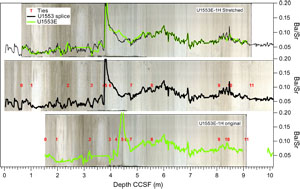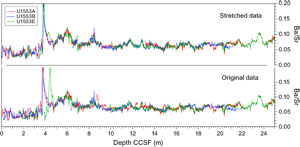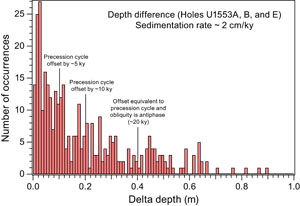Röhl, U., Thomas, D.J., Childress, L.B., and the Expedition 378 Scientists
Proceedings of the International Ocean Discovery Program Volume 378
publications.iodp.org
https://doi.org/10.14379/iodp.proc.378.202.2022
Data report: depths of Site U1553 off-splice data adjusted to the Site U1553 splice, IODP Expedition 3781
Roy H. Wilkens,2 Anna Joy Drury,3 Thomas Westerhold,4 and Ursula Röhl4
1 Wilkens, R.H., Drury, A.J., Westerhold, T., and Röhl, U., 2022. Data report: depths of Site U1553 off-splice data adjusted to the Site U1553 splice, IODP Expedition 378. In Röhl, U., Thomas, D.J., Childress, L.B., and the Expedition 378 Scientists, South Pacific Paleogene Climate. Proceedings of the International Ocean Discovery Program, 378: College Station, TX (International Ocean Discovery Program). https://doi.org/
2 School of Ocean and Earth Science and Technology, University of Hawaii, USA. rwilkens@hawaii.edu
3 Department of Earth Sciences, University College London, United Kingdom.
4 MARUM—Center for Marine Environmental Sciences, University of Bremen, Germany.
Abstract
A near-complete sedimentary sequence was spliced together for the upper part of International Ocean Discovery Program (IODP) Holes U1553A, U1553B, and U1553E. Poor core recovery precluded a complete splice for the deeper section cored in Holes U1553C and U1553D. The history of Deep Sea Drilling Project Site 277, which was cored nearby, suggests that the Site U1553 splice will be heavily sampled and that eventually samples will be taken from intervals of core that are not included in the splice (i.e., off-splice). Although the depths of all cores have been shifted to a common scale during the splicing process by aligning significant features shared by cores from the different holes, core disturbance and natural variability often lead to misalignment between features in the splice and the same features in off-splice data. To remedy this problem for future sampling, data from off-splice intervals are squeezed or stretched to match spliced intervals using a set of tie points between the splice and off-splice data. The difference in depths can be significant when considering sedimentation rates and orbital periods of precession, obliquity, and eccentricity and sometimes even change the phase relationship compared to the splice. Results are presented as tables of tie points between each hole and the splice that can be used to interpolate the proper splice depth of off-splice samples.
1. Introduction
International Ocean Discovery Program (IODP) Expedition 378 recovered the first multihole continuously cored Paleogene section from the southern Campbell Plateau (southwest Pacific Ocean). The cores are a unique record of the Paleogene for this part of the ocean and build upon the study of spot-cored Deep Sea Drilling Project Site 277. A near-complete sedimentary sequence was spliced together for the upper part of the site from Holes U1553A, U1553B, and U1553E (Drury et al., 2022). Poor core recovery precluded a complete splice for the deeper section cored in Holes U1553C and U1553D.
The history of Site 277 suggests that the Site U1553 splice will be heavily sampled and that eventually samples will be taken from intervals of core that are not included in the splice (i.e., off-splice). The depths of all cores were shifted to a common scale (core composite depth below seafloor [CCSF]) during the splicing process by aligning significant features shared by cores from the different holes. Core disturbance and natural variability often lead to misalignment between features in the splice and in the same feature in off-splice data. To remedy this for future sampling, data from off-splice intervals are squeezed or stretched to match spliced intervals through a set of tie points between the splice and off-splice data (Figure F1). The difference in tie point depths can be significant when considering sedimentation rates and orbital periods of precession, obliquity, and eccentricity, sometimes greater than an entire cycle.
2. Methods and materials
Tie points were selected visually using the Code for Ocean Drilling Data (CODD) software (Wilkens et al., 2017; https://www.codd-home.net). The process involves plotting individual core data adjacent to spliced data plotted on core images. The operator next uses cursors to identify common features in both and then stretches the off-splice data and image for comparison to the splice (Figure F1). The most prominent feature in Core 378-U1553E-1H and the top of the spliced Ba/Sr X-ray fluorescence (XRF) data is a peak at approximately 4 m CCSF in the spliced data that appears approximately 1 m deeper in the core data. The respective images also exhibit a mismatch between dark beds near the top of the core. The results of stretching Core 1H are seen in the top panel of Figure F1. The peaks in Ba/Sr and the dark beds are aligned based on the tie points. The section of data between Tie Points 8 and 9 are a contribution of Core 1H to the splice, resulting in a perfect match between core data and the splice.
3. Results
A comparison between the upper 25 m of XRF Ba/Sr data for Holes U1553A–U1553C is shown in Figure F2. In the bottom panel of the figure, data without stretching applied are plotted on the same axes. Although there is general agreement between the data from the different holes, there also are significant mismatches. The top panel is the same plot but using the stretched data. Agreement is not perfect, but there is a perceptible reduction in noise between data from the three holes.
Although it has no statistical significance, it is still useful to examine the distribution of the magnitude of depth differences between the tie points for all three holes (Figure F3) in light of the sedimentation rate at Site U1553 and its relation to the climate-related cycles of precession (~20 ky), obliquity (~41 ky), and eccentricity (~100 ky). The sedimentation rate in the upper reaches of Site U1553 roughly fluctuates around 2 cm/ky (Röhl et al., 2022). Of the 411 tie points spread over the three holes, 266 are greater or equal to 10 cm, which is the equivalent of a quarter of a precession cycle. A total of 195 ties cover differences greater than or equal to 20 cm, or half of a precession signal. Clearly, sampling off-splice core using the simple CCSF scale without stretching may result in a changing phase relationship of an important climate signal in off-splice material relative to the splice. In the case of the largest differences, it could cause antiphase behavior on precession timescales.
Tie point locations are listed in Tables T1, T2, T3, T4, and T5 for Holes U1553A, U1553B, U1553C, U1553D, and U1553E, respectively. The left sides of the tables list the tie points selected for each core, and the right sides of the tables list the off-splice depth (CCSFoffspl) and the location of the equivalent point in the core that contributes to the splice at the splice tie point depth. CCSF and CCSFoffspl depths reflect adjustments to the splice detailed in Drury et al., 2022.
4. Acknowledgments
This research used samples and/or data provided by the International Ocean Discovery Program (IODP). Funding for this research was provided by the US Science Support Program, IODP.
References
Drury, A.J., Westerhold, T., Wilkens, R.H., and Röhl, U., 2022. Data report: splice adjustment for Site U1553. In Röhl, U., Thomas, D.J., Childress, L.B., and the Expedition 378 Scientists, South Pacific Paleogene Climate. Proceedings of the International Ocean Discovery Program, 378: College Station, TX (International Ocean Discovery Program). https://doi.org/
Röhl, U., Thomas, D.J., Childress, L.B., Anagnostou, E., Ausín, B., Borba Dias, B., Boscolo-Galazzo, F., Brzelinski, S., Dunlea, A.G., George, S.C., Haynes, L.L., Hendy, I.L., Jones, H.L., Khanolkar, S.S., Kitch, G.D., Lee, H., Raffi, I., Reis, A.J., Sheward, R.M., Sibert, E., Tanaka, E., Wilkens, R., Yasukawa, K., Yuan, W., Zhang, Q., Zhang, Y., Drury, A.J., and Hollis, C.J., 2022. Site U1553. In Röhl, U., Thomas, D.J., Childress, L.B., and the Expedition 378 Scientists, South Pacific Paleogene Climate. Proceedings of the International Ocean Discovery Program, 378: College Station, TX (International Ocean Discovery Program). https://doi.org/
Wilkens, R.H., Westerhold, T., Drury, A.J., Lyle, M., Gorgas, T., and Tian, J., 2017. Revisiting the Ceara Rise, equatorial Atlantic Ocean: isotope stratigraphy of ODP Leg 154 from 0 to 5 Ma. Climate of the Past, 13(7):779–793. https://doi.org/


